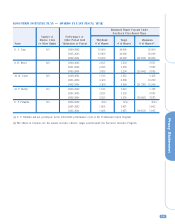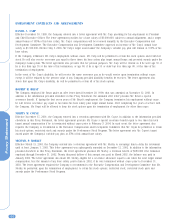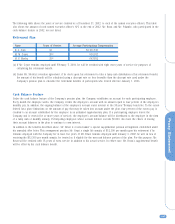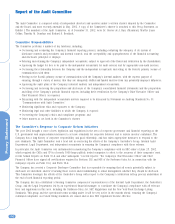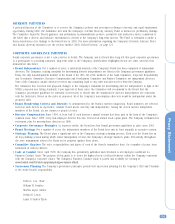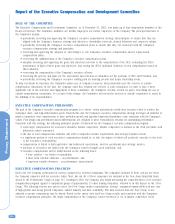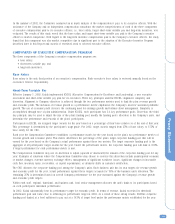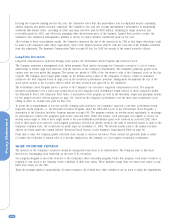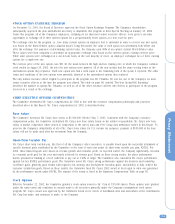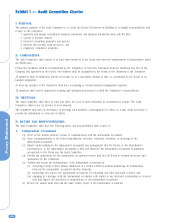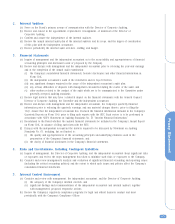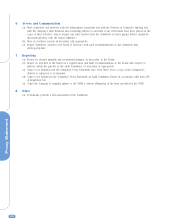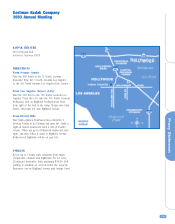Kodak 2002 Annual Report Download - page 116
Download and view the complete annual report
Please find page 116 of the 2002 Kodak annual report below. You can navigate through the pages in the report by either clicking on the pages listed below, or by using the keyword search tool below to find specific information within the annual report.
Proxy Statement
111
In the summer of 2002, the Committee conducted an in depth analysis of the compensation it pays to its executive officers. With the
assistance of the Company and an independent compensation consultant, the market competitiveness of each of the three components
of executive compensation paid to its executive officers, i.e., base salary, target short-term variable pay and long-term incentives, was
evaluated. The results of this study reveal that the base salary and target short-term variable pay paid to the Company’s executive
officers is market competitive. With regard to the long-term incentive compensation paid to the Company’s executive officers, the study
found that this component was also market competitive due in significant part to the adoption of the Executive Incentive Program
described later in this Report and awards of restricted stock to selected executive officers.
COMPONENTS OF EXECUTIVE COMPENSATION PROGRAM
The three components of the Company’s executive compensation program are:
• base salary,
• short-term variable pay, and
• long-term incentives.
Base Salary
Base salary is the only fixed portion of an executive’s compensation. Each executive’s base salary is reviewed annually based on the
executive’s relative responsibility.
Short-Term Variable Pay
Effective January 1, 2002, Kodak implemented EXCEL (Executive Compensation for Excellence and Leadership), a new executive
assessment and short-term variable pay plan for its executives. Three key principles underlie EXCEL: alignment, simplicity and
discretion. Alignment to Company objectives is achieved through the two performance metrics used to fund the plan: revenue growth
and economic profit. The inclusion of revenue growth as a performance metric emphasizes the Company’s need for sustained profitable
growth. The use of economic profit stresses the continuing need for earnings growth and balance sheet management. Simplicity is
accomplished through ease of plan administration. Under EXCEL, each participant has 3-4 key performance goals. Discretion, the third
key principle, may be used to adjust the size of the plan’s funding pool, modify the funding pool’s allocation to the Company’s units, and
determine the performance and rewards of the plan’s participants.
Participants in EXCEL are assigned target awards for the year based on a percentage of their base salaries as of the end of that year.
This percentage is determined by the participant’s wage grade. For 2002, target awards ranged from 25% of base salary, to 155% of
base salary for the CEO.
Each year the Compensation Committee establishes a performance matrix for the year based on the plan’s two performance metrics of
revenue growth and economic profit. This matrix determines the percentage of the plan’s target corporate funding pool that will be
earned for the year based on the Company’s actual performance against these two metrics. The target corporate funding pool is the
aggregate of all participants’ target awards for the year. Under the performance matrix, the corporate funding pool will fund at 100%
if target performance for each performance metric is met.
The Compensation Committee may use its discretion to adjust (upward or downward) the amount of the corporate funding pool for any
year. Examples of situations where the Compensation Committee may choose to exercise this discretion include unanticipated economic
or market changes, extreme currency exchange effects, management of significant workforce issues, significant changes in investable
cash flow, inventory turns, receivables, or capital expenditures, or dramatic shifts in customer satisfaction.
The CEO allocates the corporate funding pool among the Company’s units. Each business unit has its own targets for revenue growth
and economic profit for the year. Actual performance against these targets accounts for 75% of the business unit’s allocation. The
remaining 25% is determined based on overall Company performance for the year measured against the Company’s revenue growth
and economic profit targets.
Within each staff, regional, functional, and business unit, local senior management allocates the unit’s funds to its participants based
on each participant’s individual performance.
In 2002, Kodak substantially beat its performance target for economic profit. In terms of revenue, Kodak exceeded its threshold
performance goal and came close to achieving its performance target in 2002. As a result of these strong results, EXCEL’s corporate
funding pool funded at a level sufficient to pay out at a 143% of target level under the performance matrix established for the year.


